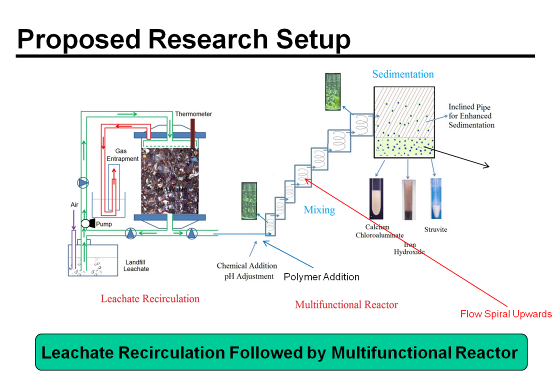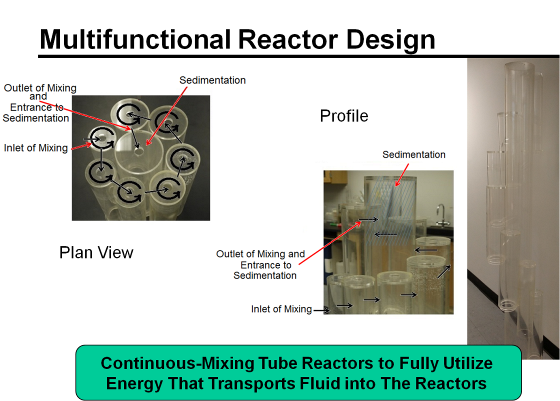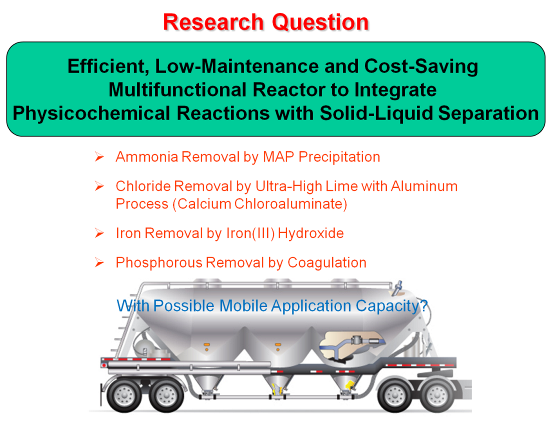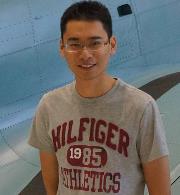
|
Gang Chen, Ph.D., P.E. |
|
Professor |
|
Multifunctional Reactor |

|
Design and Testing of a Multifunctional Energy and Space-Saving Reactor for the Treatment of Landfill Leachate |
|
Sponsored by the Hinkley Center for Solid and Hazardous Waste Management. Duration: November, 2014 to October, 2015 |
|
Objective: Nitrogen, chloride, iron and phosphorus may exist separately or co-exist in the landfill leachate. In order to efficiently treat the landfill leachate, a multifunctional energy and space-saving reactor is desirable, which should remove either one or all of these four contaminants. From our last project, we have demonstrated that aerated leachate recirculation can effectively remove the organics from landfill leachate. In this research, a novel and energy and space-saving reactor will be designed and tested for the further on-site treatment of landfill leachate in terms of ammonium, chloride, phosphorous and heavy metal removal. The overall goal of this project is to demonstrate that the designed reactor can achieve multiple functions of landfill leachate treatment depending on the treatment requirements, i.e., struvite recovery, chloride removal, phosphorous removal, or iron removal. This technology will make the on-site leachate treatment possible and thus reduce the current high costs of off-site leachate disposal means such as transporting landfill leachate via tanker trucks to local wastewater treatment plants. From this research, the efficient, low-maintenance and cost-saving multifunctional reactor will be recommended for the treatment of landfill leachate with variable compositions at landfill sites where current leachate disposal costs are high and space and environmental concerns limit other long-term options. Specific objectives of this research include: 1. Multifunctional Reactor Design, Setup and Parameter Characterization. The multifunctional reactor will be designed to enhance chemical reactions and physical separation. The hydraulic parameters will be characterized and the design of the reactor will be optimized to achieve the desired mixing for the reaction and sedimentation for the separation. 2. Testing of the Multifunction Reactor for Struvite Recovery, and Chloride, Iron and Phosphorous Removal. Operational factors such as pH, alkalinity, and dissolved oxygen will be investigated. 3. System Optimization and Cost Analysis. The multifunctional reactor operational factors will be optimized based on the treatment results and costs. Cost analysis of the optimized operations will be conducted and compared with that of off-site treatment.
Rationale: Multifunctional reactors integrate physicochemical reactions and separation operations in one apparatus. The integration gives rise to synergetic effects, which may enhance the performance of the whole system. By suitable process design, an efficient and environmental friendly process operation can be achieved, the general benefits of which include higher productivity, higher selectivity, reduced capital investment and energy consumption, improved operational safety, and improved ecological harmlessness. Multifunctional reactors are found in some areas to meet the requirements of space limitation, green engineering, and sustainable development with safe and environmental friendly processing. From our last project, we have demonstrated that aerated leachate recirculation can effectively remove the organics from landfill leachate. In this research, a novel and energy and space-saving reactor will be designed and tested for the further on-site treatment of landfill leachate in terms of ammonium, chloride, phosphorous and heavy metal removal. This project is to demonstrate that the reactor can achieve multiple functions of landfill leachate treatment depending on the treatment requirements, i.e., struvite recovery, chloride removal, phosphorous removal, and iron removal. The multifunctional reactor will be designed to enhance chemical reactions and physical separation. The hydraulic parameters will be characterized and the design of the reactor will be optimized to achieve the desired mixing for the reaction and sedimentation for the separation. In addition, operational factors will also be investigated. Especially, the multifunctional reactor operational factors will be optimized based on the treatment results and costs. This technology will make the on-site leachate treatment possible and thus reduce the current high costs of off-site leachate disposal means such as transporting landfill leachate via tanker trucks to local wastewater treatment plants. From this research, the efficient, low-maintenance and cost-saving multifunctional reactor will be recommended for the treatment of landfill leachate with variable compositions at landfill sites where current leachate disposal costs are high and space and environmental concerns limit other long-term options. |




|
Students Working on the Project |

|
Kein Vu, Ph.D. Student at Florida State University |

|
Boya Wang, Master of Science Student at Florida State University |
